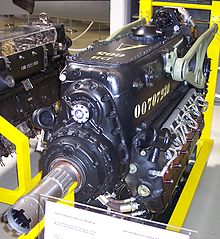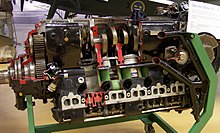Daimler-Benz DB 605
| DB 605 | |
|---|---|

| |
| A DB 605 Engine at the RAF Museum in London .
| |
| Type | Piston V12 aircraft engine |
| National origin | Germany |
| Manufacturer | Daimler-Benz
|
| First run | 1940s |
| Major applications | Messerschmitt Bf 109G Messerschmitt Bf 110G |
| Number built | 42,400 |
| Developed from | Daimler-Benz DB 601 |
The Daimler-Benz DB 605 is a German
The DB 610, a pair of DB 605s geared to turn a single output shaft that replaced the similar
License-built versions of the DB 605 were used in the
Design and development
The primary differences between the 605 and 601 were greater displacement, higher revolutions, higher compression ratio and a more powerful supercharger. Engineers determined that the cylinders could be bored out to a larger diameter without seriously affecting the strength of the existing block. The change was small, increasing the cylinder bore from the 601's 150 mm to the 605's 154 mm, but this increased the overall displacement from 33.9 litres to 35.7. Altered valve timing increased the inlet period and improved the scavenging to give greater volumetric efficiency at higher speeds, which improved the maximum allowable RPM from 2,600 in the 601 to 2,800 in the 605. The combination of these changes raised power output from 1,350 PS (1,332 hp) to 1,475 PS (1,455 hp). Engine weight increased from 700 to 756 kg.

In other ways the engine was essentially identical to the 601, being an inverted
One major design difference was the switch from ball bearings to plain bearings which, when combined with increasingly poor grades of lubricants, led to serious problems in service, including engine fires; initially, for example, the use of emergency power was forbidden. Although Daimler-Benz redesigned the bearings and added oil slingers and their associated coolers, the RLM considered the DB 605 to be a "sick engine" and the problems had not been fully resolved by the end of the war.[1]
Along with bearing difficulties, the DB 605 suffered particularly badly from the materials shortages in wartime Germany. From the outbreak of war onwards critical shortages of elements such as nickel and cobalt meant that the DB 605 had its exhaust valves reduced in nickel content from about 13.5% to 8%. This resulted in their becoming insufficiently corrosion resistant, and they began to scale in use. This scale then caused pre-ignition, which led to catastrophic detonation and eventually engine failure. This was the primary reason that the full 1.42 ata manifold pressure was not permitted, although the problems occurred for a long time before the official order restricting the power level was given (Jumo and BMW suffered exactly the same problem for some time). This was eventually fixed by applying a very heavy chrome plating to the exhaust valves, which rendered them just sufficiently resistant to scaling while still using less of a critical element than the original nickel alloy. BMW had developed this plating technique first, as the BMW 801 in the Fw 190 had also been suffering from a spate of detonation induced engine failures.[2]
Like the 601, the 605 was designed to run on "B4" fuel with an octane rating of 87. In 1944 a series of newer engines was introduced, allowing the engine to run on the 100 octane "C3" fuel and optionally including fittings for various optional power-boosting agent dispensing systems, such as the
As early as 1942 Daimler had also been working on an upgraded D-series engine that could run on either C2 or C3 fuel. The first of these, which appeared in late 1944, was a small series of DB 605DM, followed by the main production series, the DB 605DB/DC.
An unusual application of the DB 605 was its installation in a captured
Variants
- Production versions


- DB 605A
- Standard fighter engine, up to 1475 PS, B4 fuel
- DB 605AM
- 605 A with MW-50system, up to 1800 PS, C3 fuel
- DB 605AS
- Altitude optimized version of 605A using the larger DB 603 supercharger, up to 1435 PS, B4 fuel
- DB 605ASM
- 605 AS with MW-50 system, up to 1800 PS, C3 fuel
- DB 605ASB/605AB
- late-war version, first version up to 1850 PS, later reduced to 1800 PS, B4 fuel with MW-50 or C3 fuel without MW-50
- DB 605ASC
- late-war version, up to 2000 PS with MW-50, C3 fuel
- DB 605B
- Same as 605 A but for use in twin-engined aircraft like Messerschmitt Bf 110, Me 210 (different prop/gear ratio)
- DB 605BS
- proposed version for twin-engined aircraft, derived from DB 605 AS
- DB 605DB
- Improved 605 DM, standard MW-50 equipment, first version up to 1850 PS, later reduced to 1800 PS, B4 fuel with MW-50 or C3 fuel without MW-50[4]
- DB 605DC
- Improved 605 DM, standard MW-50 equipment, up to 2000 PS, C3 fuel[4]
- DB 605DM
- First DB 605 D version, standard MW-50 equipment, up to 1700 PS
- DB 605E
- proposed version for twin-engined aircraft, derived from DB 605 D
- DB 605T
- Developed to drive the HZ Anlage supercharger for the Henschel Hs 130
- DB 605 L
- Similar to 605 D but with two-stage supercharger, 1700 PS, development stopped in December 1944 [7]
- Fiat RA.1050 R.C.58 Tifone
- Licence built / developed DB 605A-1 engines, built by Fiat in Italy.
- DB 610
- Two DB 605s "coupled" (geared together) as a "power system" (71.53L / 4364.8in3), to turn a single propeller shaft, used in the Heinkel He 177A[8]Mirror-imaged starboard component engine supercharger.
- DB 610A - Propeller RH rotation - Reduction ratio 0.413: 1.[9]
- Take-off and emergency power of 2,200 kW (2,950 hp) at 2,800 rpm with 1.2 atmos. boost at sea level.[9]
- 2,000 kW (2,700 hp) at 2,800 rpm with 1.42 atmos. boost at 5,700 m (18,700 ft).[9]
- Climbing 1,950 kW (2,620 hp) at 2,600 rpm with 1.3 atmos. boost at sea level.[9]
- 1,900 kW (2,500 hp) at 2,600 rpm with 1.3 atmos. boost at 5,791 m (19,000 ft).[9]
- Maximum cruising 1,610 kW (2,160 hp) at 2,300 rpm with 1.15 atmos. boost at sea level.[9]
- 1,610 kW (2,160 hp) at 2,300 rpm with 1.15 atmos. boost at 5,486 m (18,000 ft).[9]
- Fuel consumption 0.288 kg/kWh (0.474 lb/(hp⋅h)) (max cruise at sea level).[9]
- Total length 2.13 m (7 ft 0 in) ; width 1.62 m (5 ft 4 in); height 1.04 m (3 ft 5 in) ; weight 1,580 kg (3,483 lb).[9]
- Take-off and emergency power of 2,200 kW (2,950 hp) at 2,800 rpm with 1.2 atmos. boost at sea level.[9]
- DB 610B - Propeller LH rotation - Weight 1,580 kg (3,483 lb)[9]
- DB 610C - Propeller RH rotation[9]
- Take-off and emergency power of 2,140 kW (2,870 hp) at 2,800 rpm at sea level.[9]
- 1,910 kW (2,560 hp) at 2,800 rpm at 7,620 m (25,000 ft).[9]
- Climbing 1,900 kW (2,550 hp) at 2,600 rpm at sea level.[9]
- 1,800 kW (2,400 hp) at 2,600 rpm at 7,407 m (24,300 ft).[9]
- Maximum cruising 1,600 kW (2,100 hp) at 2,300 rpm at sea level.[9]
- 1,520 kW (2,040 hp) at 2,300 rpm at 7,010 m (23,000 ft).[9]
- Take-off and emergency power of 2,140 kW (2,870 hp) at 2,800 rpm at sea level.[9]
- DB 610D - Propeller LH rotation[9]
- DB 610A - Propeller RH rotation - Reduction ratio 0.413: 1.[9]
- DB 616
- A development of the DB 605.
- DB 620
- Coupled DB628 engines.
- DB 621
- A projected two-stage supercharged DB605
- DB 625
- A turbocharged DB605
- DB 628
- The DB 605, fitted with a two-stage supercharger, abandoned in March 1944.
- IAR DB605
- Licence production in Romania by Industria Aeronautică Română (IAR).
Note: All power ratings in PS (metric horsepower). Unless otherwise noted takeoff/emergency power at sea level.
Survivors
A
in Germany with a Daimler-Benz DB 605 engine.Applications
DB 605
- Caproni Campini Ca.183bis(intended)
- Fiat G.55
- IAR 471
- Macchi C.205
- Messerschmitt Bf 109G/K
- Messerschmitt Bf 110G
- Messerschmitt Me 210
- Reggiane Re.2005
- Saab 18B, T
- Saab 21
- Savoia-Marchetti SM.91
- Savoia-Marchetti SM.92
- Savoia-Marchetti SM.93
- VL Pyörremyrsky
DB 610
- Dornier Do 317B
- Heinkel He 177A-3 and A-5
- Messerschmitt Me 261V3
- SNCAC NC.3021 Belphégor
Engines on display
Preserved DB 605 engines are on display at the
Specifications (DB 605AM)

Data from Jane's[10]
General characteristics
- Type: 12-cylinder liquid-cooled supercharged 60° inverted Vee aircraft piston engine
- Bore: 154 mm (6.06 in)
- Stroke: 160 mm (6.30 in)
- Displacement: 35.7 L (2,176 in3)
- Length: 2,158 mm (85 in)
- Width: 760 mm (30 in)
- Height: 1,037 mm (41 in)
- Dry weight: 756 kg (1,667 lb)
Components
- overhead camshaftper cylinder bank.
- MW50injection into the supercharger intake.
- Fuel system: Bosch direct fuel injection
- Oil system: Dry sump with one pressure and two scavenge pumps
- Cooling system: Liquid-cooled, pressurized
- Reduction gear: 0.594:1
Performance
- Power output:
- 1,324 kW (1,800 PS/1,775 hp) at 2,800 rpm for takeoff with MW-50 injection
- 1,250 kW (1,700 PS/1,677 hp) at 2,800 rpm at 4,000 m (13,120 ft) for maximum power with MW-50 injection
- 794 kW (1,080 PS/1,065 hp) at 2,300 rpm at 5,500 m (18,000 ft) for max continuous
- Specific power: 35.0 kW/L (0.77 hp/in3)
- Compression ratio: 7.5/7.3:1 with 87-octane fuel; 8.5/8.3:1 with 100-octane fuel
- Power-to-weight ratio: 1.68 kW/kg (1.02 hp/lb)
See also
Related development
Comparable engines
- Continental IV-1430
- Hispano-Suiza 12Z
- Junkers Jumo 213
- Rolls-Royce Merlin
Related lists
References
Notes
- ^ Mankau and Petrick 2003, p. 211.
- ISBN 978-1911658504. Retrieved 9 December 2020.
- ^ a b Mermet 1999, p. 19.
- ^ a b c Hitchcock 1979, p. 34
- ^ Mermet 1999, pp. 19–20
- ^ "German Spitfire - The Story of Mk VB (EN830) | Classic Warbirds". www.classicwarbirds.co.uk. Retrieved 2020-01-17.
- ^ Hermann and Ringlstetter 2017, p. 172-174.
- ^ Smith and Creek 2012, p. 173.
- ^ ISBN 0517679647.
- ^ Jane's 1998, p. 291
Bibliography
- Bingham, Victor (1998). Major Piston Aero Engines of World War II. Shrewsbury, UK: Airlife Publishing. ISBN 1-84037-012-2.
- Christopher, John (2013). The Race for Hitler's X-Planes: Britain's 1945 Mission to Capture Secret Luftwaffe Technology. Stroud, UK: History Press. ISBN 978-0-7524-6457-2.
- Gregor, Neil Daimler-Benz in the Third Reich. Yale University Press, 1998
- Gunston, Bill (2006). World Encyclopedia of Aero Engines: From the Pioneers to the Present Day (5th ed.). Stroud, UK: Sutton. ISBN 0-7509-4479-X.
- Jane's Fighting Aircraft of World War II. London. Studio Editions Ltd, 1989. ISBN 0-517-67964-7
- Hermann, Dietmar and Ringlstetter, Herbert. Messerschmitt Bf 109 : Vom Prototyp bis zur Bf 109 K. München, GER: GeraMond Verlag, 2017. ISBN 978-3-862-45263-7
- Hitchcock, Thomas. Bf 109K: Monogram Close-Up 16.Boylston MA: Monogram Aviation Publications, 1979. ISBN 0-914144-16-2
- Mankau, Heinz and Peter Petrick. Messerschmitt Bf 110/Me 210/Me 410: An Illustrated History. Atglen PA: Schiffer Publishing Ltd., 2003. ISBN 0-7643-1784-9
- Mermet, Jean-Claude. Messerschmitt Bf 109G-1 through K-4: Engines and Fittings. Marnaz, France: Jean-Claude Mermet SA, 1999.
- Smith, J Richard and Eddie J. Creek. Heinkel He 177 Greif: Heinkel's Strategic Bomber. Hersham, Surrey, UK: Ian Allan Publishing, 2012. ISBN 978-1-903223-93-2
